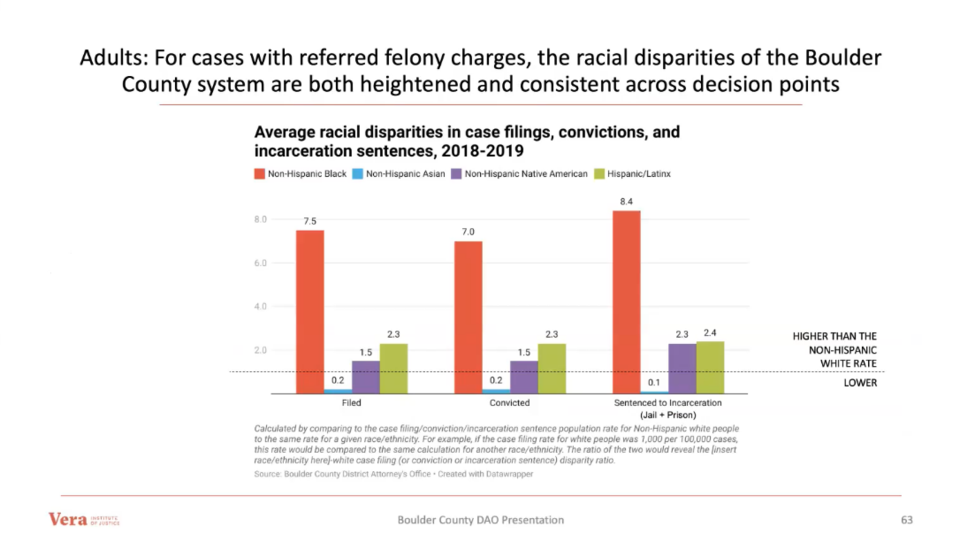A new report has found that one in 12 people sentenced to prison in Boulder County were Black despite making up one in 25 cases in the county’s overall caseload — and only 1% of the Boulder County population.
The Boulder County District Attorney’s Office was one of three offices selected to work with the Vera Institute of Justice’s Reshaping Prosecution Program to identify where and how race and ethnicity factor into the office’s many decision points. The data, which focused on cases from 2013 to 2019, was presented to the community earlier this month.
“We can’t truly ensure community safety, we cannot truly do our very best to protect the public if community members don’t trust the justice system,” Boulder County District Attorney Michael Dougherty said during the presentation.
Senior Research Associate Seleeke Flingai presented the data, which found that Latino people are in prison in Boulder County at 2.7 times the rate of white people — higher than the state and U.S. average.
Black youth and adults have seen cases filed against them at a rate of four to five times that of white youth and adults for nearly a decade. This disparity increases to 7.5 times when focusing specifically on adult felony charges.
According to the U.S. Census Bureau, 79% of the Boulder County population is white, 13% is Hispanic/Latinx and 1% is Black.
According to the data presented, the majority of cases filed in Boulder County were against white defendants, but 25% of charges filed were against Hispanic/Latinx defendants and 5% were Black. When looking at the racial disparities of who were sentenced to prison, 57% were white, 34% were Hispanic/Latinx and 7% were Black.
“So in short, we see that disparity starts at the beginning of the system and the most serious of sentences ending in prison sentences that disparity actually increases,” Flingai said.
Incarceration, including jail and prison time, is 8.4 times the rate for Black adults compared to white adults in Boulder County.
Homeless people were also overrepresented in the courts. While people experiencing homeless are estimated to make up less than 1% of Boulder County’s population, 10% of adult cases for felony charges are against homeless people.
This disparity is even greater when accounting for race, with one in five cases against Black people being homeless compared to one in nine white adults.
The data showed that Black and Hispanic/Latinx people are disproportionately sentenced to prison, while white people are disproportionately sentenced to probation only.
“In other words, the most serious outcomes are disproportionately black and brown, while non-incarceration and probation only sentences are disproportionately white,” Flingai said.
From 2013 to 2019 overall prison sentences went down in Boulder County, with less than 100 people sent to prison in 2019. In 2013, 9% of people convicted of a crime went to prison compared to 3% in 2019.
During the period studied, the district attorney’s office introduced and expanded diversion programs, which offer a path outside the traditional criminal court process. Over that time, disparities in referrals for Black youth to diversion programs have decreased and nearly disappeared for Hispanic/Latinx youth. However, for adult diversion, the disparity has increased.
Dougherty also highlighted the policy and reform that took place as the data was analyzed, like the expansion of adult and juvenile diversion along with diversion programs specifically for mental health, drug abuse and driving related issues. He said a number of legislative changes — like the decriminalization of drug possession, bond reform and a sentencing reform task force — are helping to address some of these disparities.
Dougherty emphasized that the district attorney’s office has more work to do, and that it would take partnership with the community and law enforcement officials to accomplish.
“It would be a mistake to say the District Attorney’s Office can do this alone,” he said. “It really needs to be a community effort.”
The district attorney’s office is working to create a dashboard that will be released in early September to track and share data metrics with the public. Early next year, the office plans to release another data analysis that will focus on numbers from 2019-2022.

